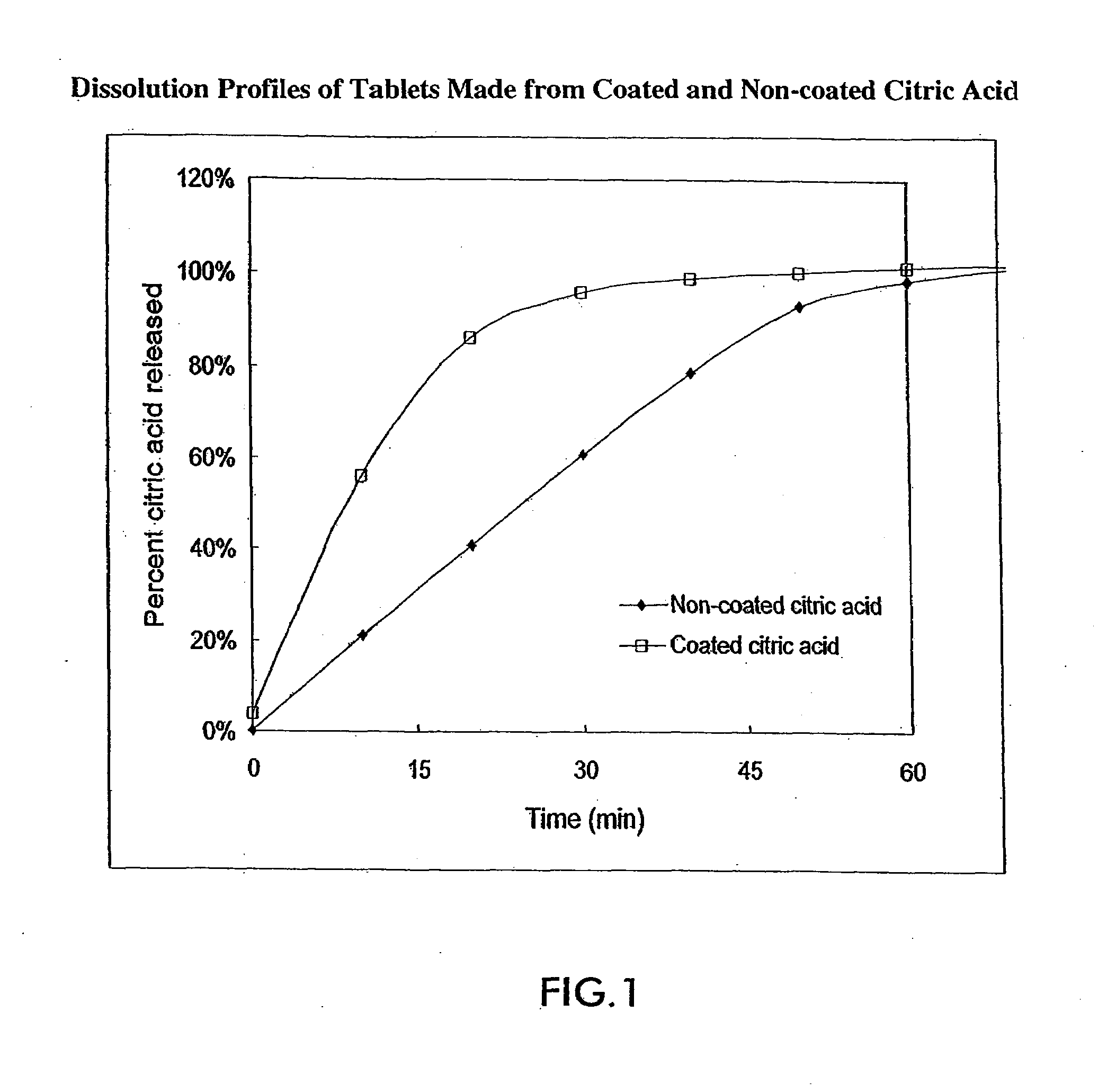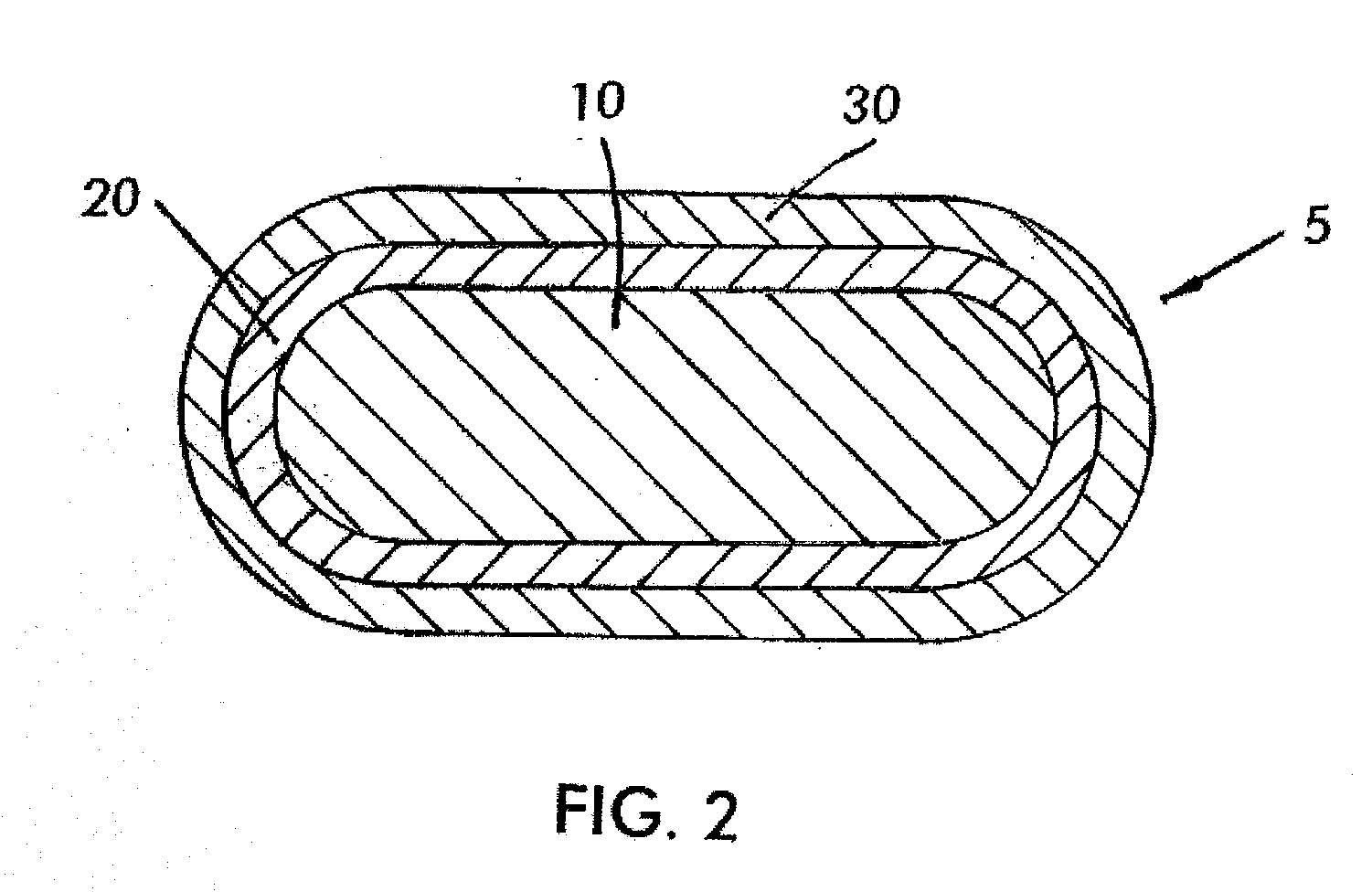Peptide pharmaceutical for oral delivery
a technology of peptide pharmaceutical and peptide, which is applied in the direction of peptide/protein ingredients, drug compositions, organic chemistry, etc., can solve the problems of significant lack of structural homology among the various calcitonin types, difficult oral administration of this type of active compound, and lack of calcitonin type homology, so as to prevent undesirable effects of acid, improve bioavailability, and improve the effect of dissolution
- Summary
- Abstract
- Description
- Claims
- Application Information
AI Technical Summary
Benefits of technology
Problems solved by technology
Method used
Image
Examples
example 1
[0095]
TABLE 1Composition of TabletsNon-coatedCitric acidCoated CitricTabletAcid TabletmgmgCitric acid powder5000Coated citric acid0500Microcrystalline cellulose112251Povidone2540Crospovidone (disintegrant)499Talc70Magnesium stearate74
[0096]Granulated citric acid tablets were prepared by compressing citric acid that was fluid-bed granulated with citric acid powder, microcrystalline cellulose and povidone with crospovidene, talc and magnesium stearate. Coated citric acid tablets were prepared by compressing glucose-coated citric acid with microcrystalline cellulose, povidone, crospovidone and magnesium stearate.
[0097]The dissolution of tablets prepared from both types of citric acid was monitored by measuring the amount of citric acid released from each tablet in a USP dissolution vessel under standard conditions. The results in FIG. 1 show that tablets prepared from coated citric acid released their contents much more rapidly than tablets prepared from non-coated citric acid. Within ...
example 2
[0098]
TABLE 2Preferred Tablet FormulationItemmgsCT.2-10Prosolv HD90200Citric Acid DC F20500Lauroyl-L-Carnitine*50Crospovidone9Kollidon VA6440Sodium Pyruvate**1Magnesium Stearate4*For tablets not containing Lauroyl-L-Carnitine add an additional 50 mg of Prosolv HD90.**Sodium pyruvate included when using peptides that can undergo methionine oxidation.
Steps for Forming tablet of Table 2
[0099]1. High shear or Comill geometrical mixing of peptide such as sCT and Prosolv.
[0100]2. Add mixed components of step 1 to V blender along with remaining components except magnesium stearate. Mix in V blender.
[0101]3. Add magnesium stearate to V blender after step 2 completed. Mix in V blender briefly.
[0102]4. Compress blend into tablets.
[0103]5. Coat tablets with subcoat to 6% weight gain.
[0104]6. Coat tablets with enteric coat to 7% weight gain.
example 3
[0105]
TABLE 3Stability of Salmon Calcitonin in Tablets Preparedfrom Coated and Non-coated Citric AcidWeeks at RoomCoated Citric AcidNon-coated Citric AcidTemperaturePercent sCT Recovered410391898811298Not determined2495Not determined3695Not determined
[0106]Salmon calcitonin was dispersed in tablets prepared from either coated or non-coated citric acid, povidone, microcrystalline cellulose, talc and magnesium stearate. The tablets were stored at 4° centigrade and room temperature for up to 36 weeks. The sCT content was determined and is summarized in Table 3 as recovery of sCT from tablets stored at room temperature relative to tablets stored at 4° centigrade. The results in Table 3 show that there was a trend toward a progressive decrease in amount of sCT in tablets prepared from non-coated citric acid, whereas sCT was significantly more stable in tablets prepared from coated citric acid.
PUM
| Property | Measurement | Unit |
|---|---|---|
| pKa | aaaaa | aaaaa |
| pKa | aaaaa | aaaaa |
| pH | aaaaa | aaaaa |
Abstract
Description
Claims
Application Information
 Login to View More
Login to View More - R&D
- Intellectual Property
- Life Sciences
- Materials
- Tech Scout
- Unparalleled Data Quality
- Higher Quality Content
- 60% Fewer Hallucinations
Browse by: Latest US Patents, China's latest patents, Technical Efficacy Thesaurus, Application Domain, Technology Topic, Popular Technical Reports.
© 2025 PatSnap. All rights reserved.Legal|Privacy policy|Modern Slavery Act Transparency Statement|Sitemap|About US| Contact US: help@patsnap.com


